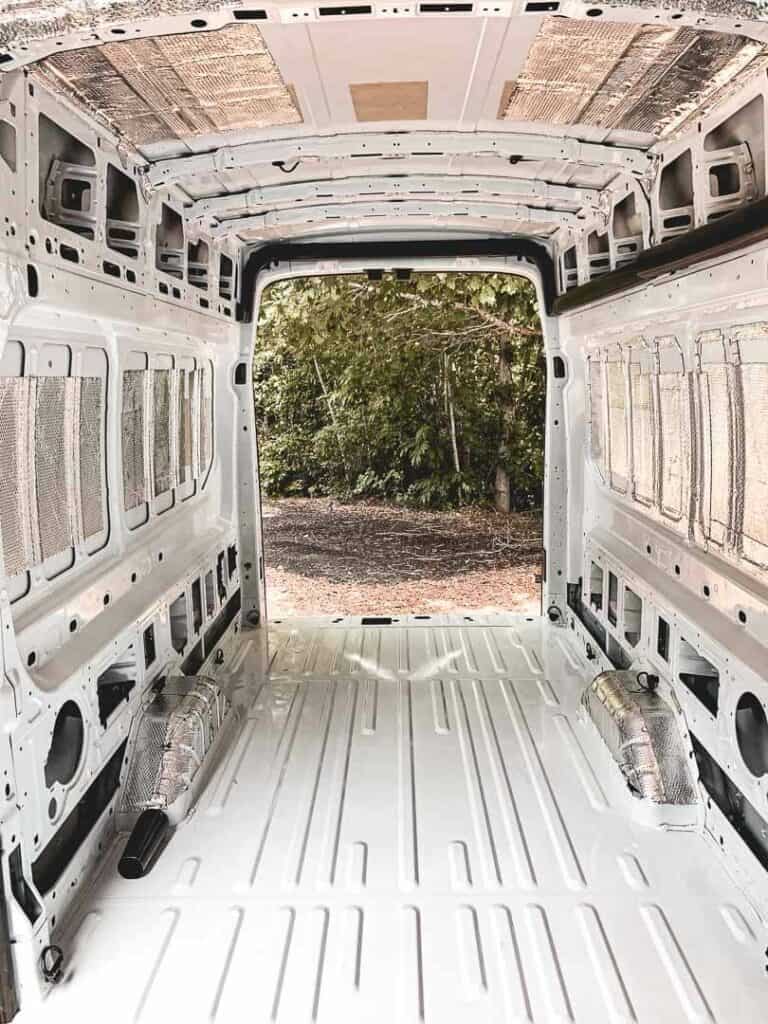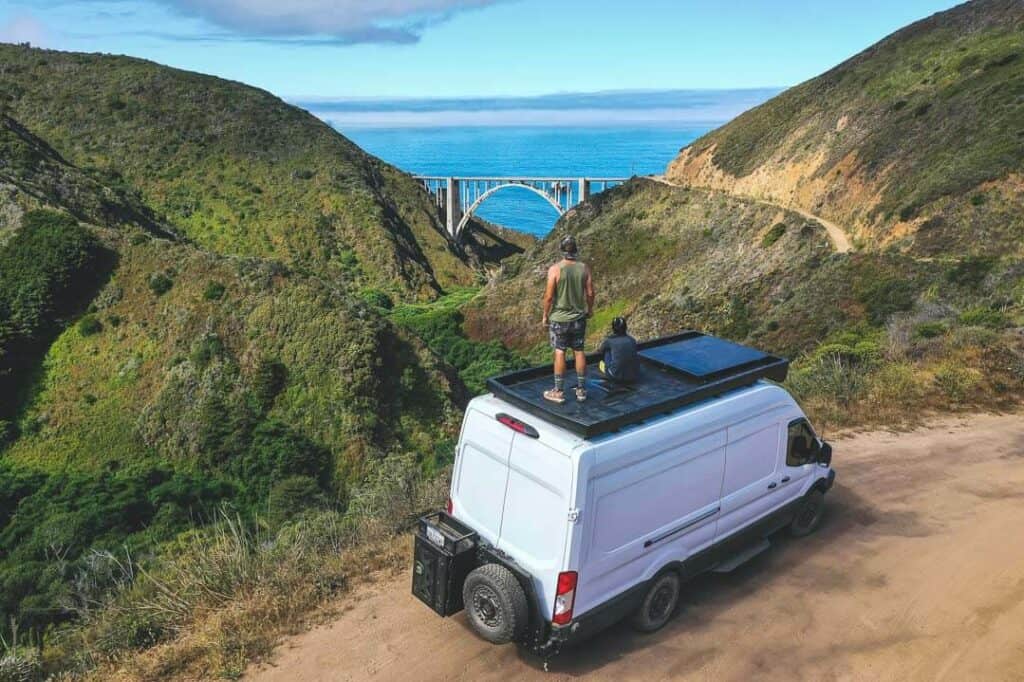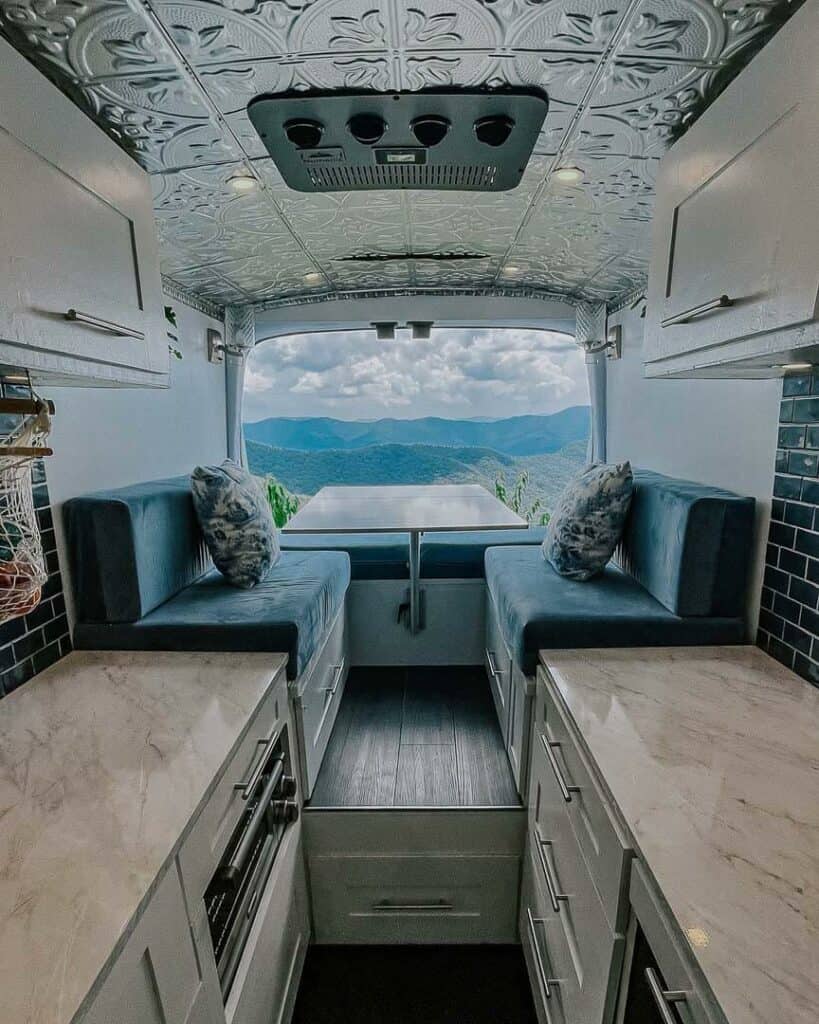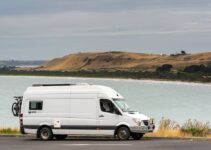Considering a Ford Transit for van life conversion? Here’s everything you need to know about why the Ford Transit may be the best cargo van for van life!
When it comes to choosing the best van for a camper conversion, you probably know that there are 3 primary options for van living to choose from – Mercedes Sprinter, Dodge Promaster and Ford Transit.
But if you are like us, weighing the options on which of these mostly similar vans will offer the best layout with the most interior space and best drive performance in addition to which will offer the easiest conversion process can be complicated.
In fact, we found that every time we made a decision on which van we wanted to build we quickly changed our mind upon touring a newly converted cargo van. Mercedes Sprinters have long been the go-to when it comes to van conversion.
But the Ford Transit has a lot to offer and we lean very heavily into this make and model being the best option for any van build.
So as you start thinking about what you are looking for in a camper van conversion, read on for the complete guide as to why we think that Ford Transit camper vans are perfect for van life!
OPTIONS
| 130” Wheelbase (LOW ROOF) | 130” Wheelbase (MEDIUM ROOF) | 148” Wheelbase (LOW ROOF) | 148” Wheelbase (MEDIUM ROOF) | 148” Wheelbase (HIGH ROOF) | 148” Wheelbase Extended-Length (HIGH ROOF) |
External Length | 219.9" | 217.8" | 237.6" | 235.5" | 235.5" | 263.9" |
External Height | 82.2" | 99.1" | 82.9" | 101.3" | 109.6" | 110.4" |
External Width | 81.3" | 81.3" | 81.3" | 81.3" | 81.3" | 81.3" |
Ground Clearance | 5.6" | 5.6" | 5.6" | 5.6" | 5.6" | 5.6" |
Rear Overhang | 49.7" | 49.7" | 47.6" | 47.6" | 47.6" | 76.0" |
Interior Standing Room | 56.9" | 72.0" | 56.9" | 72.0" | 81.5" | 81.5" |
Max Cargo Volume | 280.9 Cu Ft | 358.7 Cu Ft | 311.9 Cu Ft | 400.5 Cu Ft | 453.4 Cu Ft | 536.4 Cu Ft |
Why A Ford Transit for Van Life Makes The Perfect Campervan Conversion
Before investing in any van build you should have an idea of the pros and cons of each van. Unless you’ve been given a van for free, shopping for the right van to build can be complicated. And the truth is, there is no perfect van out there.
But we really like Ford Transit camper vans and have come across a wide range of van builds in the van life community that gives evidence as to why the Ford Transit camper van may be the best on the market.
So whether you plan to complete your own van conversion or will hire a company like Sportsmobile to do the conversion, the Ford Transit is likely the best choice for a number of reasons. Let’s get into those below.
PROS
- Tallest roof height option (6’8”)
- Affordable
- Rear-wheel with all-wheel drive options
- Eco-boost engine (turbo V6)
- Common mechanics (for repairs & maintenance)
- Inexpensive maintenance & repairs
- Dual rear wheel options (longer wheelbase)
- Semi-boxy for building
CONS
- Mostly newer models
- Gasoline engine (diesel option)
- Low ground clearance (around 5”)
- 15-17 mpg average fuel economy
- Not as common in van life
WHAT WE LIKE ABOUT THE FORD TRANSIT
While there are lots of things to love about the Ford Transit, here’s a breakdown of our favorite features you should consider in any Ford Transit camper van build.
Tallest Roof Option
The Ford Transit stands above the rest, literally, when it comes to standard roof height. With a 6’8″ roof height option, you will have more space for your build and, most importantly, you will have plenty of standing space.
If you’re tall, you can stand upright in virtually any Ford Transit camper van. You don’t have to invest in a pop-top (although we have seen several great Ford Transits with an additional pop-top) and you don’t have to plan to spend much of your time hunched over in the Ford Transit.
This extra space will allow you to create a floor plan with a little more storage space here or there and you can build out the van to feel very roomy with the tall roof.

Affordability
Ford has been in the automobile business for over a century and has excelled at producing high-quality vehicles at affordable prices. The Ford Transit is at a comparable price point as the Dodge Promaster. But it is significantly more affordable than a Mercedes Sprinter.
While it may not seem like much to save a few thousand dollars on the purchase price of your van, these extra savings will go a long way toward your Ford Transit van conversion.
And there is a decent-sized secondary market for used Ford Transits that make them even more affordable.
Common Mechanics
One of the top reasons to invest in a Ford Transit for your camper van conversion is because the mechanical build of the vehicle is very common. In other words, there are very few places you could possibly break down where you could not find any mechanic capable of making repairs.
And while most people don’t buy a van thinking about the times it will break down, the reality is that both maintenance and repair costs will add up over time and it can be incredibly frustrating, time-consuming and costly to require specialized parts and/or mechanics to work on your van.
Low Maintenance Cost
Side-by-side with the common mechanics of the Ford Transit is the fact that it has relatively low maintenance costs as well. We’re big believers in preventative maintenance. And being able to change your own oil in a Wal-Mart parking lot is a huge plus that many people overlook.
For instance, if you purchase a late-model Mercedes Sprinter you physically cannot change your own oil. You have to find the time and money to take it to a dealership wherever you may be traveling to have something as basic as an oil change completed for you.
Rear-Wheel Drive with All-Wheel Drive Train Options
If you are like us when you had your first dream about your van conversion you pictured a 4×4 beast capable of meeting the challenges of any offroad adventure. But then as reality (and budget) sets in you may have realized that you may not actually need a 4-wheel drive vehicle.
We like the Ford Transit because it is rear-wheel drive (RWD), with all-wheel drive (AWD) options.
As opposed to front-wheel drive (FWD), rear-wheel gives better overall traction and handling. Unless you plan to spend most of your time in the snow, where FWD excels in safety, rear-wheel drive is great with a camper van conversion because the weight is distributed more equally between the front and back of the van.
And when it comes to getting “unstuck” in sand or mud, RWD offers the most help and comes in a close second to AWD or the 4WD we all once dreamed about in our van conversion.
But RWD or AWD also reduces fuel economy and adds weight to the vehicle.

Dual Rear Wheel Options
Along with the rear-wheel or all-wheel drive train, you can opt for a Ford Transit with a dual-rear-wheel axle which will make your van more capable of carrying heavy loads. As you should know, understanding the impact of weight on a van or RV is important for many reasons.
The general principle is, the lighter the load the better. However, when it comes to completing a camper van conversion, there is no doubt that weight may be an afterthought to ensuring you have the best electrical system, water tanks, storage space, kitchen area and bed setup.
So if you’re planning to build the Taj Mahal of camper van conversions, knowing that the Ford Transit offers a dual-rear-wheel axle option may set your mind at ease about how much weight you end up adding throughout the build process.
READ NEXT: Check out this post to find out more about the other most common vans for van conversion!
THINGS TO CONSIDER
While there are a lot of things to like about the Ford Transit camper van, there are a few things to consider before shopping for one.
Less Common
There are far fewer Ford Transit camper vans on the road than Promaster or Mercedes Sprinters. There is no particular reason for this. However, the fact remains that fewer Ford Transits on the road means you may struggle to find a truly complete guide and other resources to help you build out your tiny home on the road the way you want it.
Fewer Used Models Available
The Ford Transit is also a relatively new cargo model and thus there are fewer used vans on the market. If you’re not in a hurry, we suspect there will be a significant number of all sorts of used vans available once the COVID-era van lifers return to brick-and-mortar life.
But until then, it may be difficult to search and find a used Ford Transit if you are looking to cut down on cost right from the start.

Low Ground Clearance
Although 4WD or AWD may give you an edge when trying to get out of the sand or mud, the overall low ground clearance of the Ford Transit camper van may be a big turn off when it comes to picking out the best van for you.
While you may have enough common sense to not get stuck during your vanlife adventure, there are going to be countless dirt roads that you will come across and you will be tempted to turn down nearly every one of them. But if you realize how low your clearance is, you will have to second-guess every potential dirt road adventure.
You can add bigger tires (which we always recommend all-terrain tires anyway) and you can learn to navigate rough terrain in a way that doesn’t leave you bottomed out or high-centered. But you definitely want to be aware that the Ford Transit is not the most ideal for an off-road adventure out of the factory.
Fuel Economy
Although we think that 15-17 mpg is great fuel economy after having lived over two years in an RV that only gets 7 mpg, you may not be too thrilled about this fuel economy.
And while there is little difference between the three main types of converted vans when it comes to fuel economy, every little bit of fuel cost adds up over time. The devil is in the details, so they say.
SAMPLE FORD TRANSIT CONVERSIONS
As we started our research to find the best van for our van conversion, we came across several great examples of different Ford Transit camper van conversions that we think exemplify some of the points we’ve highlighted in this post so far.
If you’re looking for other great examples of converted Ford Transits, be sure to check out our friend’s conversions. We think they’ve each done a great job with their floor plan layout, taking into account the overall cost of their camper van conversion with the necessities of full-time life on the road.
Lauren and Jon with Stella.The.Van

Lauren converted a 2018 Ford Transit high-roof extended-length van. She purchased the van used for $36,000 but it only had about 13,500 miles on it.
Then she put about $25,000 – $30,000 into building it out with the primary costs being $10,000 for the entire electrical system including solar, $3500 for a 12V AC unit, $1,500 for a roof rack and $1,400 for an isotherm fridge.
FORD TRANSIT CAMPERVAN RESOURCES
For more information specific to Ford Transit conversions, check out the following resources:
- Ford Transit Order Guide – How to decide which options are right for your Ford Transit build
- FarOutRide’s Ford Transit Conversion Guide – Everything you need to know to build out your Transit
- Ford Transit Kit – Parts you will want for your build


